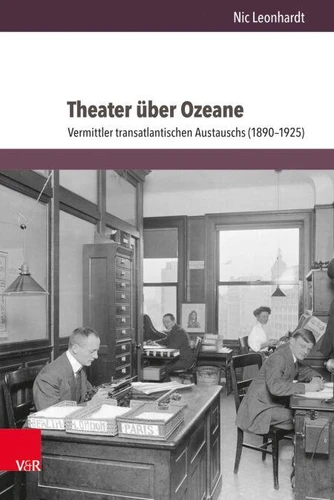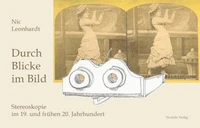Theater über Ozeane. Vermittler transatlantischen Austauschs (1890–1925)
Par :Formats :
Disponible dans votre compte client Decitre ou Furet du Nord dès validation de votre commande. Le format PDF est :
- Compatible avec une lecture sur My Vivlio (smartphone, tablette, ordinateur)
- Compatible avec une lecture sur liseuses Vivlio
- Pour les liseuses autres que Vivlio, vous devez utiliser le logiciel Adobe Digital Edition. Non compatible avec la lecture sur les liseuses Kindle, Remarkable et Sony
 , qui est-ce ?
, qui est-ce ?Notre partenaire de plateforme de lecture numérique où vous retrouverez l'ensemble de vos ebooks gratuitement
Pour en savoir plus sur nos ebooks, consultez notre aide en ligne ici
- Nombre de pages341
- FormatPDF
- ISBN978-3-8470-0805-7
- EAN9783847008057
- Date de parution03/12/2018
- Protection num.pas de protection
- Taille12 Mo
- Infos supplémentairespdf
- ÉditeurV&R Unipress
Résumé
Sei es Artistik, Oper, Tanz, Schauspiel, Musical, Comedy oder Drama: die internationale Theaterszene im späten 19. und frühen 20. Jahrhundert wurde stark durch professionelle, international tätige Vermittler (Agenten, Broker) gesteuert. Dieser Band betritt die infrastrukturellen »Hinterbühnen« globaler kultureller Mobilität im Zeitraum von 1890 bis 1925. Diskursiv verortet sich die Studie im Forschungsfeld der Globalgeschichte und -theorie.
Der gewählte geographische Fokus ist ein transatlantischer, begründet durch den regen Austausch zwischen Europa und Nord- sowie Südamerika. Die enorme Handlungsmacht der Vermittler im fokussierten Zeitraum wurde bisher kaum wissenschaftlich erforscht. Am Beispiel ausgewählter Agentinnen und Agenten erörtert die Autorin Professionalisierung und Praktiken künstlerischer transatlantischer Vermittlung. Artistic performances, opera, dance, acting, musical, comedy or drama: the international theatre scene in the late 19th and early 20th century was strongly controlled by professional and international operating agents and brokers.
This volume focuses on the infrastructural "backstages" of global cultural mobility from 1890 to 1925. From a discoursive perspective the study is located in the study field of global history and theory. Due to the strong exchange between Europe and North and South America a transatlantic geographical focus has been selected. The enormous power of the agents during this time has merely been analysed yet.
The author explains professionalisation and methods of artistic transatlantic agencies from the example of selected agents.
Der gewählte geographische Fokus ist ein transatlantischer, begründet durch den regen Austausch zwischen Europa und Nord- sowie Südamerika. Die enorme Handlungsmacht der Vermittler im fokussierten Zeitraum wurde bisher kaum wissenschaftlich erforscht. Am Beispiel ausgewählter Agentinnen und Agenten erörtert die Autorin Professionalisierung und Praktiken künstlerischer transatlantischer Vermittlung. Artistic performances, opera, dance, acting, musical, comedy or drama: the international theatre scene in the late 19th and early 20th century was strongly controlled by professional and international operating agents and brokers.
This volume focuses on the infrastructural "backstages" of global cultural mobility from 1890 to 1925. From a discoursive perspective the study is located in the study field of global history and theory. Due to the strong exchange between Europe and North and South America a transatlantic geographical focus has been selected. The enormous power of the agents during this time has merely been analysed yet.
The author explains professionalisation and methods of artistic transatlantic agencies from the example of selected agents.
Sei es Artistik, Oper, Tanz, Schauspiel, Musical, Comedy oder Drama: die internationale Theaterszene im späten 19. und frühen 20. Jahrhundert wurde stark durch professionelle, international tätige Vermittler (Agenten, Broker) gesteuert. Dieser Band betritt die infrastrukturellen »Hinterbühnen« globaler kultureller Mobilität im Zeitraum von 1890 bis 1925. Diskursiv verortet sich die Studie im Forschungsfeld der Globalgeschichte und -theorie.
Der gewählte geographische Fokus ist ein transatlantischer, begründet durch den regen Austausch zwischen Europa und Nord- sowie Südamerika. Die enorme Handlungsmacht der Vermittler im fokussierten Zeitraum wurde bisher kaum wissenschaftlich erforscht. Am Beispiel ausgewählter Agentinnen und Agenten erörtert die Autorin Professionalisierung und Praktiken künstlerischer transatlantischer Vermittlung. Artistic performances, opera, dance, acting, musical, comedy or drama: the international theatre scene in the late 19th and early 20th century was strongly controlled by professional and international operating agents and brokers.
This volume focuses on the infrastructural "backstages" of global cultural mobility from 1890 to 1925. From a discoursive perspective the study is located in the study field of global history and theory. Due to the strong exchange between Europe and North and South America a transatlantic geographical focus has been selected. The enormous power of the agents during this time has merely been analysed yet.
The author explains professionalisation and methods of artistic transatlantic agencies from the example of selected agents.
Der gewählte geographische Fokus ist ein transatlantischer, begründet durch den regen Austausch zwischen Europa und Nord- sowie Südamerika. Die enorme Handlungsmacht der Vermittler im fokussierten Zeitraum wurde bisher kaum wissenschaftlich erforscht. Am Beispiel ausgewählter Agentinnen und Agenten erörtert die Autorin Professionalisierung und Praktiken künstlerischer transatlantischer Vermittlung. Artistic performances, opera, dance, acting, musical, comedy or drama: the international theatre scene in the late 19th and early 20th century was strongly controlled by professional and international operating agents and brokers.
This volume focuses on the infrastructural "backstages" of global cultural mobility from 1890 to 1925. From a discoursive perspective the study is located in the study field of global history and theory. Due to the strong exchange between Europe and North and South America a transatlantic geographical focus has been selected. The enormous power of the agents during this time has merely been analysed yet.
The author explains professionalisation and methods of artistic transatlantic agencies from the example of selected agents.





